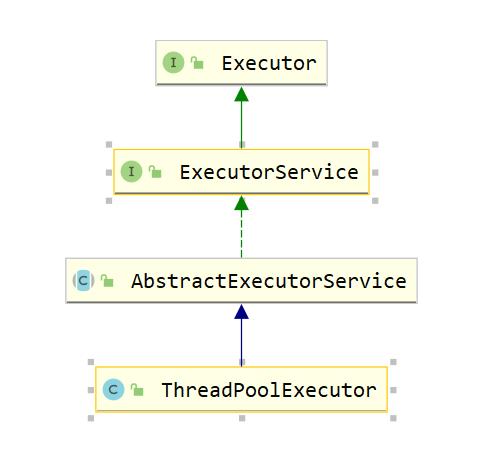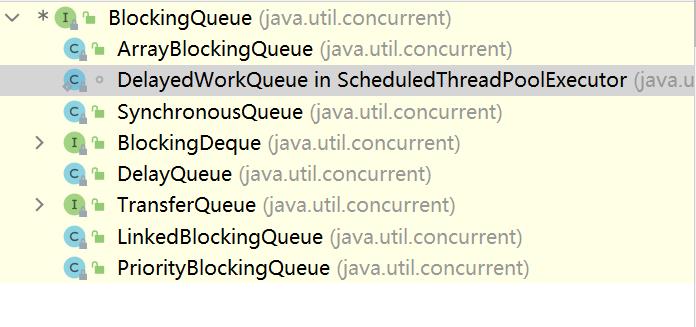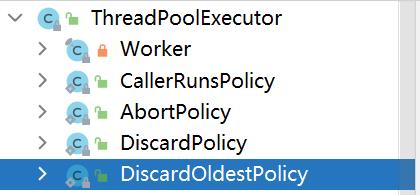看了就能学会的Java线程池技术
Posted 活跃的咸鱼
tags:
篇首语:本文由小常识网(cha138.com)小编为大家整理,主要介绍了看了就能学会的Java线程池技术相关的知识,希望对你有一定的参考价值。
线程池
1.线程池的介绍
1.1 线程池的概念
线程池:Java中开辟出了一种管理线程的概念,这个概念叫做线程池,使用池的技术可以降低资源消耗(常见的池技术有jdbc连接池,线程池,内存池,对象池)。
1.2 为什么要提出线程池的概念
程序运行的本质是cpu进程的调度(占用系统的资源)进程是一个动态的过程,是一个活动的实体。简单来说,一个应用程序的运行就可以被看做是一个进程,而线程,是运行中的实际的任务执行者。可以说,进程中包含了多个可以同时运行的线程。而在Java中,内存资源是极其宝贵的,所以,我们就提出了线程池的概念。
1.3 线程池的好处
(1)降低资源消耗。通过重复利用已创建的线程降低线程创建和销毁造成的消耗。
(2)提高响应速度。当任务到达时,任务可以不需要等到线程创建就能立即执行。
(3)提高线程的可管理性。线程是稀缺资源,如果无限制的创建,不仅会消耗系统资源,还会降低系统的稳定性,使用线程池可以进行统一的分配,调优和监控。
2. 线程池的使用
2.1 线程池的创建
我们可以通过ThreadPoolExecutor来创建一个线程池。
ThreadPoolExecutor类是线程池的核心实现类,用来执行被提交的任务。其继承关系如下。

下面我们来分析一下ThreadPoolExecutor类我们来看看ThreadPoolExecutor类的构造方法:
public ThreadPoolExecutor(int corePoolSize,
int maximumPoolSize,
long keepAliveTime,
TimeUnit unit,
BlockingQueue<Runnable> workQueue) {
this(corePoolSize, maximumPoolSize, keepAliveTime, unit, workQueue,
Executors.defaultThreadFactory(), defaultHandler);
}
public ThreadPoolExecutor(int corePoolSize,
int maximumPoolSize,
long keepAliveTime,
TimeUnit unit,
BlockingQueue<Runnable> workQueue,
ThreadFactory threadFactory) {
this(corePoolSize, maximumPoolSize, keepAliveTime, unit, workQueue,
threadFactory, defaultHandler);
}
public ThreadPoolExecutor(int corePoolSize,
int maximumPoolSize,
long keepAliveTime,
TimeUnit unit,
BlockingQueue<Runnable> workQueue,
RejectedExecutionHandler handler) {
this(corePoolSize, maximumPoolSize, keepAliveTime, unit, workQueue,
Executors.defaultThreadFactory(), handler);
}
public ThreadPoolExecutor(int corePoolSize,
int maximumPoolSize,
long keepAliveTime,
TimeUnit unit,
BlockingQueue<Runnable> workQueue,
ThreadFactory threadFactory,
RejectedExecutionHandler handler) {
if (corePoolSize < 0 ||
maximumPoolSize <= 0 ||
maximumPoolSize < corePoolSize ||
keepAliveTime < 0)
throw new IllegalArgumentException();
if (workQueue == null || threadFactory == null || handler == null)
throw new NullPointerException();
this.corePoolSize = corePoolSize;
this.maximumPoolSize = maximumPoolSize;
this.workQueue = workQueue;
this.keepAliveTime = unit.toNanos(keepAliveTime);
this.threadFactory = threadFactory;
this.handler = handler;
}
从源码中我们发现ThreadPoolExecutor有四个构造方法,所以有四种创建方法,在四个构造函数中一共有七个参数下面来对七个参数进行说明。
2.2 线程池的七大参数
(1)、corePoolSize(核心线程数,必需指定):
线程池的基本大小。当提交一个任务到线程池时,线程池会创建一个线程来执行任务,即使其他空闲的基本线程能够执行新任务也会创建线程,等到需要执行的任务数大于基本线程时就不再创建。如果调用了线程池的prestartAllCoreThreads()方法,线程池会提前将核心线程创建并启动。默认情况下,核心线程会一直存活,但是当将 allowCoreThreadTimeout 设置为 true 时,核心线程也会超时回收。
(2)、maximumPoolSize(必需指定,线程池最大数量):
线程池所能容纳的最大线程数。如果队列满了,并且已创建的线程数小于最大线程数,则线程池会创建新的线程执行任务。不过要注意,如果使用了无界的任务队列这个参数则没有任何效果,因为线程创建要等到队列满了才会创建。
(3)、keepAliveTime(必需指定,线程活动保持的最长时间):
线程池的工作线程空闲后,保持的存活时间,所以如果任务很多,并且每个任务执行的时间比较短,可以调大时间,提高线程的利用率。如果超过该时长,非核心线程就会被回收。如果将allowCoreThreadTimeout 设置为 true 时,核心线程也会超时回收。
(4)、TimeUnit(必需指定):
指定keepAliveTime 参数的时间单位。常用的有:TimeUnit.MILLISECONDS(毫秒)、TimeUnit.SECONDS(秒)、TimeUnit.MINUTES(分)。
(5)、BlockingQueue (任务队列,必需指定):
用于保存等待执行的任务的阻塞队列,通过线程池的 execute() 方法提交的 Runnable 对象将存储在该参数中。
阻塞队列的阻塞分两种情况:
- 当队列满的时候去写会阻塞
- 当队列为空的时候去读也会阻塞
BlockingQueue:四组API
| 功能 | 抛出异常 | 不抛出异常且有返回值 | 阻塞等待 | 超时等待 |
|---|---|---|---|---|
| 添加 | add() | offer() | put() | offer(…) |
| 移除 | remove() | poll() | take() | poll(…) |
| 检查队首元素 | element() | peek() | - | - |
//抛异常
public static void test1(){
System.out.println(queue.add("a"));
System.out.println(queue.add("b"));
System.out.println(queue.add("c"));
//队列满 抛出IllegalStateException
System.out.println(queue.add("d"));
System.out.println("---------------------");
System.out.println(queue.remove());
System.out.println(queue.remove());
System.out.println(queue.remove());
//如果队列为空 NoSuchElementException
System.out.println(queue.remove());
//返回队首的元素
System.out.println(queue.element());
}
//不抛异常,成功则会返回true失败返回false
public static void test2(){
System.out.println(queue.offer("d"));
System.out.println(queue.offer("d"));
System.out.println(queue.offer("d"));
//队列满不抛异常会返回false
System.out.println(queue.offer("d"));
System.out.println(queue.poll());
System.out.println(queue.poll());
System.out.println(queue.poll());
//没有元素弹出会返回null
System.out.println(queue.poll());
//返回队首的元素
System.out.println(queue.peek());
}
//等待阻塞(一直阻塞)
public static void test3()throws Exception{
queue.put("a");
queue.put("b");
queue.put("c");
//阻塞等待一直阻塞
queue.put("d");
queue.take();
queue.take();
queue.take();
//没有元素也会一直阻塞
queue.take();
}
//等待超时退出
public static void test4()throws InterruptedException{
System.out.println(queue.offer("d"));
System.out.println(queue.offer("d"));
System.out.println(queue.offer("d"));
//阻塞两秒后自动退出
System.out.println(queue.offer("d",2,TimeUnit.SECONDS));
System.out.println(queue.poll(2, TimeUnit.SECONDS));
System.out.println(queue.poll(2, TimeUnit.SECONDS));
System.out.println(queue.poll(2, TimeUnit.SECONDS));
//阻塞两秒后自动退出
System.out.println(queue.poll(2, TimeUnit.SECONDS));
}
任务队列是基于阻塞队列实现的,即采用生产者消费者模式,在 Java 中需要实现 BlockingQueue 接口。该接口的实现子类如下:

ArrayBlockingQueue:一个由数组结构组成的有界阻塞队列(数组结构可配合指针实现一个环形队列),此队列按照先进先出原则对元素进行排序。
LinkedBlockingQueue: 一个由链表结构组成的有界阻塞队列,也是按照先进先出排序元素,吞吐量要高于ArrayBlockingQueue,静态工厂方法Executors.newFixedThreadPool使用了这个队列。在未指明容量时,容量默认为 Integer.MAX_VALUE。
PriorityBlockingQueue: 一个支持优先级排序的无界阻塞队列,对元素没有要求,可以实现 Comparable 接口也可以提供 Comparator 来对队列中的元素进行比较。跟时间没有任何关系,仅仅是按照优先级取任务。
DelayQueue:类似于PriorityBlockingQueue,是二叉堆实现的无界优先级阻塞队列。要求元素都实现 Delayed 接口,通过执行时延从队列中提取任务,时间没到任务取不出来。
SynchronousQueue: 一个不存储元素的阻塞队列,消费者线程调用 take() 方法的时候就会发生阻塞,直到有一个生产者线程生产了一个元素,消费者线程就可以拿到这个元素并返回;生产者线程调用 put() 方法的时候也会发生阻塞,直到有一个消费者线程消费了一个元素,生产者才会返回。
public class TestSynchronousQueue {
public static void main(String[] args) {
BlockingQueue<String> queue=new SynchronousQueue<>();
new Thread(()->{
try {
TimeUnit.SECONDS.sleep(2);
System.out.println(Thread.currentThread().getName()+" put a");
queue.put("a");
TimeUnit.SECONDS.sleep(2);
System.out.println(Thread.currentThread().getName()+" put b");
queue.put("b");
} catch (InterruptedException e) {
e.printStackTrace();
}
},"product").start();
new Thread(()->{
try {
TimeUnit.SECONDS.sleep(2);
System.out.println(Thread.currentThread().getName()+"=>"+ queue.take());
TimeUnit.SECONDS.sleep(2);
System.out.println(Thread.currentThread().getName()+"=>"+ queue.take());
} catch (InterruptedException e) {
e.printStackTrace();
}
},"consumer").start();
}
}
结果:
product put a
consumer=>a
product put b
consumer=>b
LinkedBlockingDeque: 使用双向队列实现的有界双端阻塞队列。双端意味着可以像普通队列一样 FIFO(先进先出),也可以像栈一样 FILO(先进后出)。
LinkedTransferQueue: 它是ConcurrentLinkedQueue、LinkedBlockingQueue 和 SynchronousQueue 的结合体,但是把它用在 ThreadPoolExecutor 中,和 LinkedBlockingQueue 行为一致,但是是无界的阻塞队列。
注意:
有界队列和无界队列的区别:如果使用有界队列,当队列饱和时并超过最大线程数时就会执行拒绝策略;而如果使用无界队列,因为任务队列永远都可以添加任务,所以设置maximumPoolSize 没有任何意义。
(6)、ThreadFactory(线程工厂,可选):用于指定为线程池创建新线程的方式,还可以为每个创建出来的线程设置线程名。使用开源框架guava提供的ThreadFactoryBuilder可以快速的设置。
new ThreadFactoryBuilder().setNameFormat("XX-task-%d").build();
(7)、 RejectedExecutionHandler(拒绝策略,可选):当达到最大线程数时需要执行的饱和策略。
当线程池的线程数达到最大线程数时,需要执行拒绝策略。拒绝策略需要实现 RejectedExecutionHandler 接口,并实现 rejectedExecution(Runnable r, ThreadPoolExecutor executor) 方法。在ThreadPoolExecutor类中实现了 4 种拒绝策略:

AbortPolicy(默认):丢弃任务并抛出 RejectedExecutionException 异常。
public class Demo1 {
public static void main(String[] args) {
//创建一个核心线程为2,最大容量线程为5线程闲置超时时长为3秒,采取拒绝策略的线程池
ThreadPoolExecutor poolExecutor = new ThreadPoolExecutor(2, 5, 3, TimeUnit.SECONDS,
new ArrayBlockingQueue<>(3), Executors.defaultThreadFactory(),
new ThreadPoolExecutor.AbortPolicy());
//最大承载=最大容量线程+队列数量=8
//9>8超过最大承重量报RejectedExecutionException
for (int i = 0; i < 9; i++) {
poolExecutor.execute(()->{
System.out.println(Thread.currentThread().getName());
});
}
}
}
测试结果:
pool-1-thread-1
pool-1-thread-3
pool-1-thread-2
pool-1-thread-4
pool-1-thread-3
pool-1-thread-1
pool-1-thread-5
pool-1-thread-2
Exception in thread "main" java.util.concurrent.RejectedExecutionException: Task threadpool.demo2$$Lambda$14/0x0000000100066840@71be98f5 rejected from java.util.concurrent.ThreadPoolExecutor@6fadae5d[Running, pool size = 5, active threads = 5, queued tasks = 0, completed tasks = 3]
at java.base/java.util.concurrent.ThreadPoolExecutor$AbortPolicy.rejectedExecution(ThreadPoolExecutor.java:2055)
at java.base/java.util.concurrent.ThreadPoolExecutor.reject(ThreadPoolExecutor.java:825)
at java.base/java.util.concurrent.ThreadPoolExecutor.execute(ThreadPoolExecutor.java:1355)
at threadpool.demo2.main(demo2.java:16)
CallerRunsPolicy:由调用线程处理该任务。
public class Demo2 {
public static void main(String[] args) {
//创建一个核心线程为2,最大容量线程为5线程闲置超时时长为3秒
ThreadPoolExecutor poolExecutor = new ThreadPoolExecutor(2, 5, 3, TimeUnit.SECONDS,
new ArrayBlockingQueue<>(3), Executors.defaultThreadFactory(),
new ThreadPoolExecutor.CallerRunsPolicy());
//最大承载=最大容量线程+队列数量
//超过由调用线程处理该任务。
for (int i = 0; i < 9; i++) {
poolExecutor.execute(()->{
System.out.println(Thread.currentThread().getName());
});
}
}
}
超过了由主线程来处理
pool-1-thread-1
pool-1-thread-3
main
pool-1-thread-2
pool-1-thread-2
pool-1-thread-2
pool-1-thread-2
pool-1-thread-4
pool-1-thread-5
DiscardPolicy:丢弃任务,但是不抛出异常。可以配合这种模式进行自定义的处理方式。
public class Demo3 {
public static void 以上是关于看了就能学会的Java线程池技术的主要内容,如果未能解决你的问题,请参考以下文章